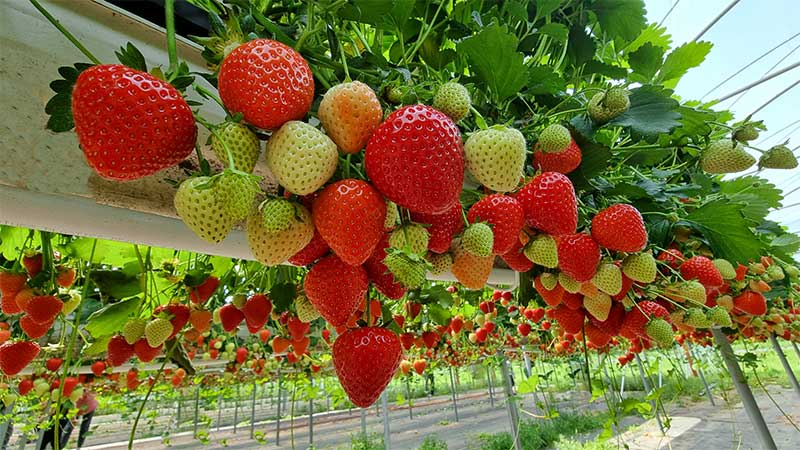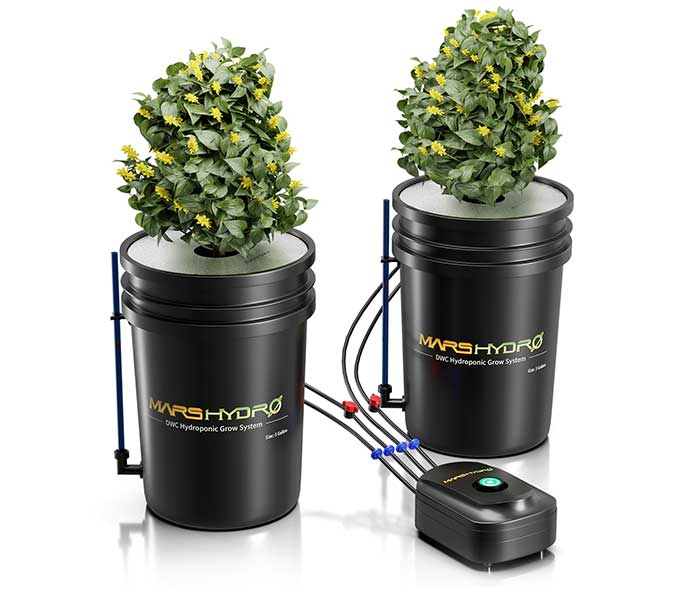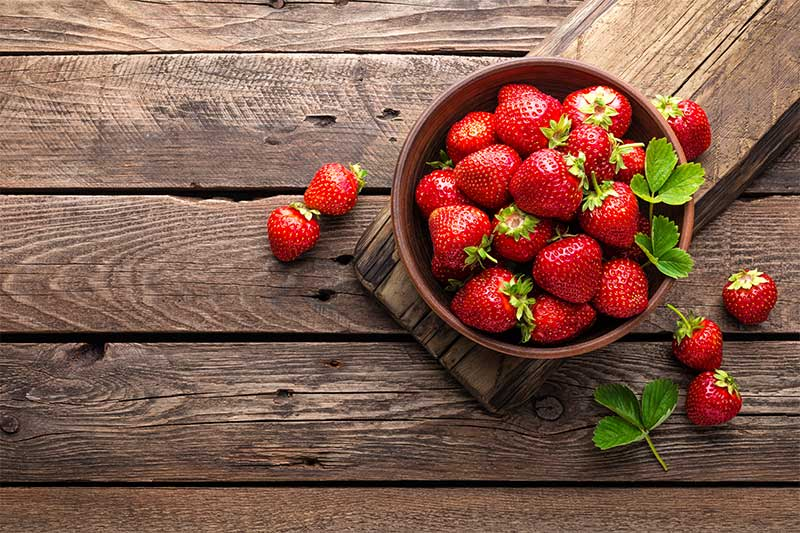Hydroponic gardening has transformed the cultivation of various crops, and strawberries are no exception. Imagine relishing fresh, juicy hydroponic strawberries year-round, right in the comfort of your home. Hydroponics provides an efficient and space-saving solution for growing these delectable berries. In this guide, we'll delve into the world of hydroponic strawberries, exploring the benefits of this cultivation method and offering practical tips for a successful harvest.
What Are Hydroponic Strawberries?
Hydroponic strawberries refer to strawberries cultivated using a hydroponic growing system instead of traditional soil-based methods. Hydroponics, a method of growing plants without soil, utilizes nutrient-rich water solutions to deliver essential nutrients directly to the plant roots. This soilless cultivation technique creates an efficient and controlled environment for plant growth, ensuring optimal conditions for hydroponic strawberries.
Benefits of Hydroponic Strawberries
Year-Round Harvest
Embracing hydroponic cultivation for strawberries introduces the transformative advantage of year-round harvests. By exerting control over the growing environment, hydroponic systems break free from the constraints of seasonal variations. Bid farewell to the limitations of traditional planting schedules, and relish the ability to enjoy fresh strawberries at any time of the year. This not only enhances accessibility but also elevates the overall flexibility and convenience of hydroponic strawberry cultivation.
Space Efficiency
Hydroponic systems emerge as a beacon of efficiency, especially for those grappling with limited gardening space. The adaptability of hydroponics enables the implementation of space-maximizing techniques such as vertical towers, nutrient film techniques (NFT), or vertical farming setups. This innovation in spatial utilization empowers cultivators to optimize their available area, fostering the cultivation of larger quantities of hydroponic strawberries in a confined space. The compact nature of hydroponic setups transforms small spaces into productive hubs of strawberry abundance.
Water Conservation
Hydroponic strawberry cultivation champions sustainability by significantly reducing water consumption compared to traditional soil-based gardening. Employing closed-loop systems, hydroponics efficiently recycles water, minimizing overall water usage. This eco-friendly approach not only addresses water scarcity concerns but also aligns with global efforts towards responsible resource management. Choosing hydroponics for strawberries reflects a conscientious commitment to environmental preservation through the conservation of this precious resource.
Precise Nutrient Control
The precision afforded by hydroponic systems in managing nutrient delivery stands as a cornerstone for the robust health and productivity of hydroponic strawberry plants. This meticulous control allows cultivators to tailor nutrient solutions to the unique requirements of hydroponic strawberries at different growth stages. By fine-tuning the nutrient composition, hydroponic practitioners ensure that the plants receive an optimal blend of elements, fostering healthier growth and substantially enhancing yield quantities. This nuanced approach exemplifies the capacity of hydroponics to elevate crop quality through tailored nutrition, marking it as a method that not only maximizes productivity but also cultivates a healthier harvest.
Growing Hydroponic Strawberries
Selecting Strawberry Varieties
The success of growing hydroponic strawberries begins with the careful selection of varieties. Opt for cultivars well-suited for hydroponic cultivation. Varieties such as Albion or Seascape, classified as everbearing or day-neutral, prove to be excellent choices for their ability to provide a continuous and prolific harvest. This strategic selection ensures a prolonged and reliable yield from your hydroponic system.
Choosing a Hydroponic System
Navigate the diverse landscape of hydroponic systems to find the one that aligns with your specific needs. The choice should be influenced by factors such as available space, budget constraints, and personal preferences. By evaluating these variables, you can make an informed decision that maximizes efficiency and optimizes the growth of your hydroponic strawberries.
Elevate your hydroponic gardening experience with the revolutionary Mars Hydro 5-Gallon DWC Hydroponic System. This state-of-the-art 5-gallon deep water culture kit is designed to provide optimal conditions for vibrant, healthy vegetables and plants, both indoors and outdoors. Perfect for hydroponic enthusiasts of all levels, this system comes equipped with essential components to ensure your hydroponic strawberries thrive.
Key Features:
1. All-Inclusive Kit:
- The Mars Hydro 5-Gallon DWC Hydroponic System is a comprehensive solution that includes 2x 5-gallon PP plant buckets, 2x 8-inch grow baskets, 2x drip irrigation sets, 1x air pump, 4m of air tubing, 2x air stones, 2x packs of clay pebbles, 2x visual water level indicators, 2x valve connections, and a detailed instruction booklet. Everything you need for successful hydroponic strawberries cultivation is included in this premium kit.
2. Upgraded Design with Top-Feed Drip:
- Our innovative hydroponic system now features a unique top-feed drip, ensuring your plants receive a continuous supply of nutrient-rich water for maximum absorption and impressive growth rates. This upgrade sets the stage for unparalleled productivity in your hydroponic garden.
3. Durable Plant Buckets:
- The two heavy-duty 5-gallon plant buckets are constructed from superior PP material, providing long-lasting durability. The spacious 8-inch grow baskets accommodate multiple plants, creating an ideal environment for robust root development and overall plant health.
4. Optimized Airflow for Rapid Growth:
- The Mars Hydro air pump, boasting an impressive 7 L/min output, operates efficiently at 110-120V/60HZ with an 8W power rating. Paired with our high-efficiency air stone, it delivers a consistent stream of air bubbles, ensuring optimal oxygen levels for rapid and healthy root growth.
5. Comprehensive Hydroponic Setup:
- From robust plant buckets and grow baskets to efficient drip irrigation sets and air stones, our DWC kit provides a complete hydroponic solution. The package also includes 4m of air tubing, clay pebbles, visual water level indicators, valve connections, and a handy instruction booklet for easy setup and maintenance.
6. Grow Anywhere, Anytime:
- The Mars Hydro 5-Gallon DWC Hydroponic System opens the door to year-round gardening, offering fresh, organic produce in soilless environments. Whether you're cultivating in grow tents, greenhouses, patios, or balconies, this system is the ideal solution for urban gardeners, home culinary enthusiasts, and professionals seeking sustainable alternatives.
Creating the Right Growing Environment
To facilitate robust strawberry growth, it is imperative to establish an environment that mirrors their natural habitat. Maintain a stable temperature range between 60-80°F (15-27°C), ensuring optimal conditions for growth. Maintain relative humidity levels between 60-80% to create an environment conducive to flourishing hydroponic strawberry plants.
Additionally, supplement natural light with LED grow lights like VG40R, carefully calibrated to meet the light requirements of hydroponic strawberries. Utilizing red light in the 650-665nm range is instrumental in enhancing various aspects of hydroponic strawberry growth. This specific spectrum is crucial for efficient photosynthesis, stimulating flowering, and promoting robust fruit development. It plays a vital role in photomorphogenesis, influencing leaf expansion, stomatal regulation, and overall plant architecture. In the context of hydroponics, red light accelerates seed germination, supports early seedling growth, and contributes to controlled plant development. By utilizing red LED grow lights, hydroponic growers can optimize the light spectrum in indoor setups, ensuring healthier and more productive strawberry plants through strategic exposure to red light wavelengths.
This comprehensive approach to the growing environment is pivotal in ensuring the success of your hydroponic strawberry garden.
Nutrient Solution
The formulation of a nutrient-rich solution is a critical aspect of hydroponic strawberry cultivation. Prepare a solution containing essential elements such as nitrogen, phosphorus, potassium, and micronutrients. Regularly monitor pH levels to fine-tune the nutrient absorption process, ensuring that your hydroponic strawberries receive an optimal balance of nutrients for robust growth and fruit production.
Planting Strawberries
The choice of growing media is crucial in hydroponic strawberry cultivation. Opt for soilless options like coconut coir or rock wool to provide a clean and disease-free environment for your hydroponic strawberry plants. When planting, pay careful attention to spacing, promoting adequate air circulation and preventing the onset of diseases. This meticulous approach to planting sets the foundation for a thriving hydroponic strawberry garden, maximizing both yield and quality.
Care and Maintenance of Hydroponic Strawberries
Pruning and Training
Elevate the productivity of your hydroponic strawberry garden through diligent pruning and training practices. Regularly trim runners and excess foliage to divert the plant's energy towards optimal fruit production. Embrace the use of a well-designed trellis system to support the hydroponic strawberry plants, keeping strawberries elevated above the ground. This not only minimizes the risk of rot but also facilitates efficient air circulation, promoting a healthier growing environment. By mastering the art of pruning and training, you empower your hydroponic strawberries to thrive and maximize their yield potential.
Pest and Disease Management
Vigilance is key in preserving the health of your hydroponic strawberry crop. Stay proactive in identifying and addressing potential threats from common pests in hydroponic strawberries and diseases. Implement preventative measures, such as introducing beneficial insects that act as natural predators, to maintain a balanced ecosystem within your hydroponic system. Simultaneously, uphold a meticulous standard of cleanliness in your growing environment, minimizing the risk of disease development. A comprehensive approach to pest and disease management ensures the sustained well-being of your hydroponic strawberries and secures a bountiful harvest.
Harvesting
The timing of harvesting plays a pivotal role in the flavor and quality of hydroponically grown strawberries. Monitor your hydroponic strawberry plants diligently and harvest strawberries at their peak ripeness. Hydroponically cultivated strawberries often mature faster than their soil counterparts, emphasizing the importance of regular monitoring. Implement a systematic approach to harvesting, considering factors such as color, firmness, and overall size to determine the optimal moment for picking. By adhering to these meticulous harvesting practices, you ensure that each hydroponic strawberry contributes to the overall excellence of your hydroponic harvest.
Conclusion
Growing hydroponics strawberries is a rewarding venture that offers sweet, fresh berries throughout the year. By harnessing the benefits of hydroponics and providing the right conditions, you can cultivate a thriving hydroponic strawberry garden right in your home. Whether you're a novice or experienced gardener, hydroponic strawberries are a delightful addition to any indoor garden.
Embark on this flavorful journey of hydroponic strawberry cultivation and experience the joy of harvesting your own delicious hydroponic berries, no matter the season. Happy growing!








